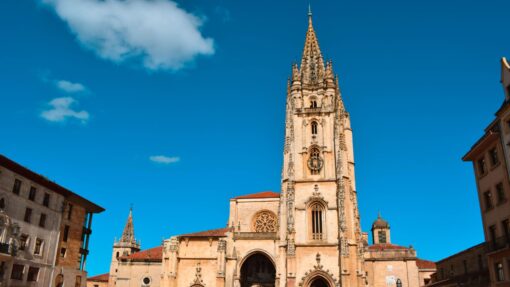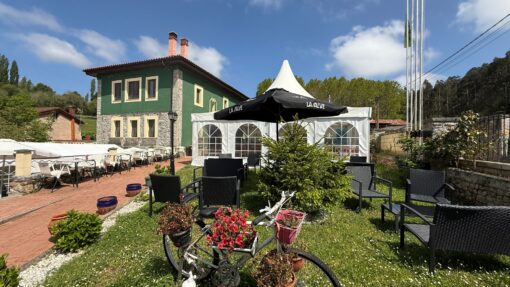Inspired by: El Camino para Latinos
Recommended stay: Villa Palatina, in Paladín
The Primitive Way is, for many, the most authentic version of the Way. It’s a challenging route, yes — with fewer services, more solitude, and rugged terrain — but it also offers something unmatched: a raw, honest connection with the land, the history, and yourself.
If you’re about to begin this journey, the best thing you can do is start it well. This article is designed for those who want to truly experience the Way from day one — without rushing, without rookie mistakes, and with both mind and body ready for the path ahead.
Oviedo: where it all begins
The Primitive Way begins in Oviedo — and that’s no coincidence. In the 9th century, King Alfonso II the Chaste set out from his court here to visit the recently discovered tomb of the apostle St. James. His pilgrimage was the first. This route is the origin of the Way.
But Oviedo is more than just history. It’s also culture, cuisine, and the first contact with the lush, green Asturian landscape. Giving yourself a day to adapt to the region — its weather, pace, and atmosphere — isn’t wasted time. It’s part of the preparation.

Before you walk, plan smart
The first 72 hours on the Way can shape the rest of your experience. Ideally, you should arrive in Oviedo at least one day before your first walking stage.
How to get to Oviedo from Madrid
From Madrid, the most comfortable option is the Renfe Alvia train, which takes around 4.5 hours from Chamartín station. Alternatively, you can take an ALSA bus from either the airport or the Estación Sur.
What matters most isn’t the transport itself — it’s the pace: arrive early, check in calmly, eat well, and rest. The Way starts long before your first step.
Day -1: arrive and slow down
The day before you start walking is not for sightseeing or squeezing in last-minute errands. It’s for relaxing, adjusting your backpack, testing your gear, and letting your body and mind settle into what’s about to begin.
If you need to get your Pilgrim Credential, you can do so in Oviedo at:
-
The Cathedral of San Salvador (Plaza Alfonso II el Casto)
-
The Tourist Office (Plaza de la Constitución, 4)
-
The Basilica of San Juan el Real (Calle Doctor Casal)
-
Or the municipal pilgrim hostel (if staying there)
With some energy left, visit a few highlights nearby without overdoing it: San Francisco Park, El Fontán Market, or the pre-Romanesque churches of Santa María del Naranco and San Miguel de Lillo — essential sites to understand the spiritual and cultural roots of this route.
Day 1: Oviedo to Paladín (~19 km)
The first walking day is special. Everything is new — the weight of your backpack, the first yellow arrows, the feeling of the path beneath your boots.
No need to cover long distances on day one. A perfect target is the quiet hamlet of Paladín, home to Villa Palatina — a welcoming pilgrim hostel offering great food, a peaceful atmosphere, and a terrace where you can truly enjoy your arrival.
Even if you’re not staying the night, stop there to eat. Their cachopo is worth the detour.

Day 2: Paladín to Casazorrina (~25 km)
With your body now adjusted, this second stage is when you start to find your rhythm. It’s a longer walk, with a mix of rural paths, quaint towns, and a few gentle hills.
Many stop in Cornellana, but for a quieter night, Casazorrina is a great alternative. Only consider walking on to Salas if you still have plenty of energy, as that route stretches to 28 km.
Tip: Stop in Grado — about halfway — to grab breakfast, restock supplies, or withdraw cash.
Day 3: Casazorrina to Tineo (~23 km)
By now, walking feels more natural. You’re not just testing yourself anymore — you’re truly on the Way.
This stage is a bit long, but manageable if you’ve taken it easy so far. Tineo is a proper town with all essential services — perfect for laundry, groceries, or a well-earned rest.
If you’re feeling strong, you can continue on to Campiello, but it’s not necessary. Tineo is more than enough for a restorative night.
Optional Day 4: Tineo to Colinas de Arriba (~22 km)
If you’re extending your journey, this stage leads you deeper into peaceful, rural Asturias — a rewarding path for those who want to walk without pressure and enjoy the solitude.
Travel light: your body will thank you
One of the most common beginner mistakes is overpacking. Luckily, there are practical alternatives:
-
Send your main luggage ahead to Santiago and walk with a light daypack
-
Arrange daily luggage transport between stages
-
Check with your accommodation about local baggage services
Companies like Correos or TaxiCamino offer reliable options. Walking light isn’t cheating — it’s smart.
A good start makes all the d ifference
ifference
The first 72 hours aren’t just a physical stretch. They set the tone for everything that follows. Resting well, walking with awareness, and staying at places with soul — like Villa Palatina — can transform your Way.
Start slowly. Be present. Pay attention to every step, every view, every conversation. When you begin in the right way, it stays with you long after you’ve reached Santiago.

